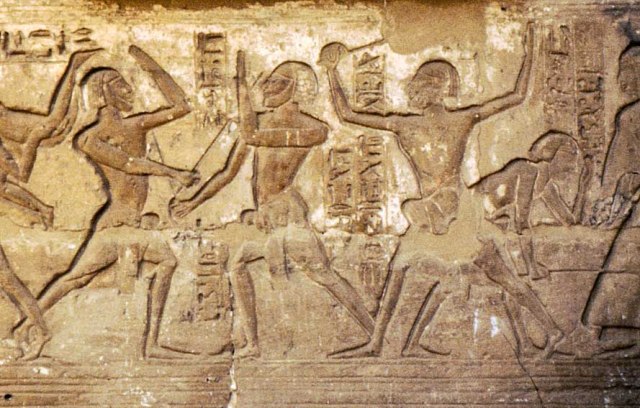http://columbiaclassicalfencing.com/2012/11/03/parallels-between-classical-european-ancient-egyptian-fencing-bouts/
Classical fencing emerged in Europe during the late 18th Century in Europe. It is not surprising that swordsmanship has been practiced by a myriad of cultures outside of Europe, or that fencing reaches well beyond the 18th Century. What is surprising is how similar judged fencing bouts are between classical European and ancient Egyptian fencers, despite the great span of time and geography.
Classical fencing emerged in Europe during the late 18th Century in Europe. It is not surprising that swordsmanship has been practiced by a myriad of cultures outside of Europe, or that fencing reaches well beyond the 18th Century. What is surprising is how similar judged fencing bouts are between classical European and ancient Egyptian fencers, despite the great span of time and geography.
A Classical Fencing Bout
Modern “sport” fencing uses an electrical scoring apparatus to determine which fencer touches his or her adversary first in the valid target area. When two classical fencers bout, an electrical scoring apparatus is not used. Instead, a number of judges participate in the bout. As practiced historically and presently in classical fencing salles, judges are positioned at the flank and to the rear of each competitor in a bout. A president oversees the bout, calling the fencers to the ready with the command, “en garde” followed by the command to begin fencing with, “Allez!” Should a judge observe a fencer landing a touch on the opponent’s valid target area, the judge will raise his or her hand. The president will determine if the touch was valid, both in target-area and firmness of hit (enough pressure to have caused injury with a real weapon in lieu of a practice weapon). The president also keeps score. Classical bouts usually proceed until one opponent receives three or five touches from his or her opponent.
Fencing in Ancient Egypt
Classical fencers will undoubtedly recognize the similarities between their craft and the competitive bouting that occurred in ancient Egypt thousands of years ago. Evidence of similarities comes from the archaeological record at the temple of Rameses III at Medinent Habu. Within the temple, scenes dating to over 3,150 years ago record ethnically different groups in the Egyptian army bouting in fencing matches. The bouts were in celebration of Rameses III’s defeat of the Libyans, and carved images commemorate his success. The Egyptian stone-carved images show competitors wearing protective headgear (secured with chinstrap), and the fencers use a stick blunted at the tip. A knuckle guard protects the hand (Piccione, 345-346). Classical and modern fencers use practice-weapons that are“foiled” at the tip to help prevent injury, and fencers wear protective masks.

Egyptian stick fencers recorded at Medinet Habu. The stone-carved images show competitors who wear protective headgear, fence with a stick blunted at the tip. A knuckle guard protects the hand. © Copyright Su Bayfield, all rights reserved. Image used with permission.
A View of Ancient Egyptian Bouts
Classical fencers will undoubtedly recognize an Egyptian pre-bout ritual, also recorded at Medinet Habu. There, an Egyptian fencer calls on his Nubian competitor to,
“Establish yourself for me (i.e., “on guard!”), for I shall cause you to see the hand of a warrior! (MH 2, pl. 111, col. 30; cf Edgerton and Wilson 1936, p. 140)” (as cited in Piccione, 346).
One style of Egyptian Fencing Stick. Fencing sticks were made of bundled reeds with a wooden prong at the hilt. Fencers are always shown gripping the weapon above the prong, which perhaps served as rest for the heel of the hand (after Decker 1992 as cited in Piccione).
Remarkable similarities come from the tomb of Kheruef during the Eighteenth Dynasty (over 3,360 years ago). The tomb records some of the celebratory events that occurred during a festival for Pharaoh Amenhotep III (Tutankhamun’s grandfather). Fencers bout with a practice weapons constructed of bundled papyrus reeds. The “men of Pe” compete against of the “men of Dep” in judged bouts (ibid, 342). Just as is observed in a fencing bout in classical salles today, the scene recorded in the tomb of Kheruef shows two judges in profile overlapping one another and standing to the rear (and apparently to the flanks) of a competitor. Corresponding to classical fencing in the European tradition, the Egyptian judges raise their hands indicating a valid hit against the opponent. The corresponding captions read,
“hit!”
“hit 2 times!”
“You have no opponent!”
(Kheruref pls. 61-63 as cited in Piccione, 342-343)
“hit 2 times!”
“You have no opponent!”
(Kheruref pls. 61-63 as cited in Piccione, 342-343)

Judges stand beside and to the flank of competitors who fence with bundled reeds. They indicate a scored hit with raised hands (after Kheruef, pls 61, 63 as cited in Piccione with modifications).
The latter statement, “You have no opponent!” is somewhat in question as to the exact meaning. Piccione strongly suggests that this is a statement of admonishment to one fencer who is depicted stepping on the foot of his competitor, perhaps as the judges threw out the touch due to a rule violation. However, Piccione also points out that the exact phrase is used elsewhere in the tomb in a song addressing a triumphant king, giving credence to the assertion that the successful fencer has shown his competitor the “hand of a warrior” and emerged victorious.
No comments:
Post a Comment